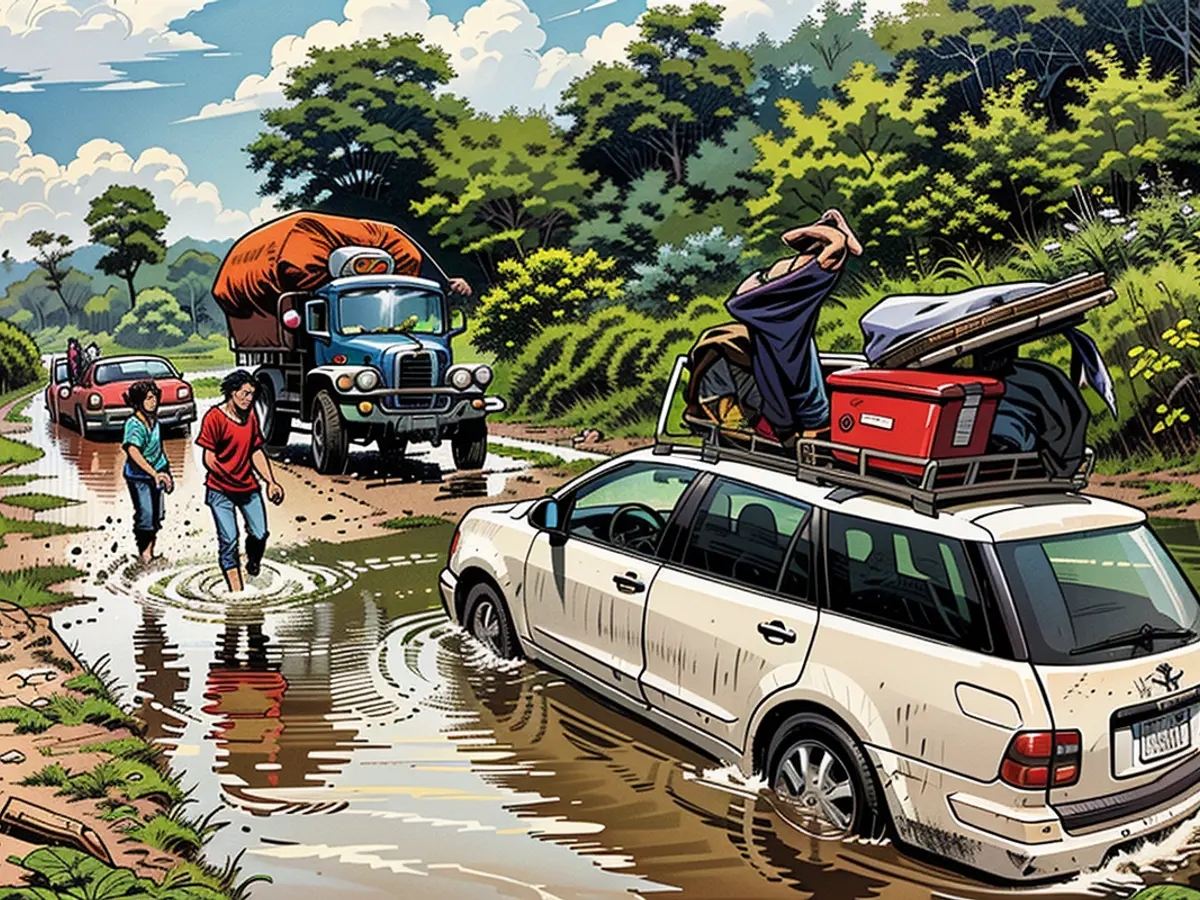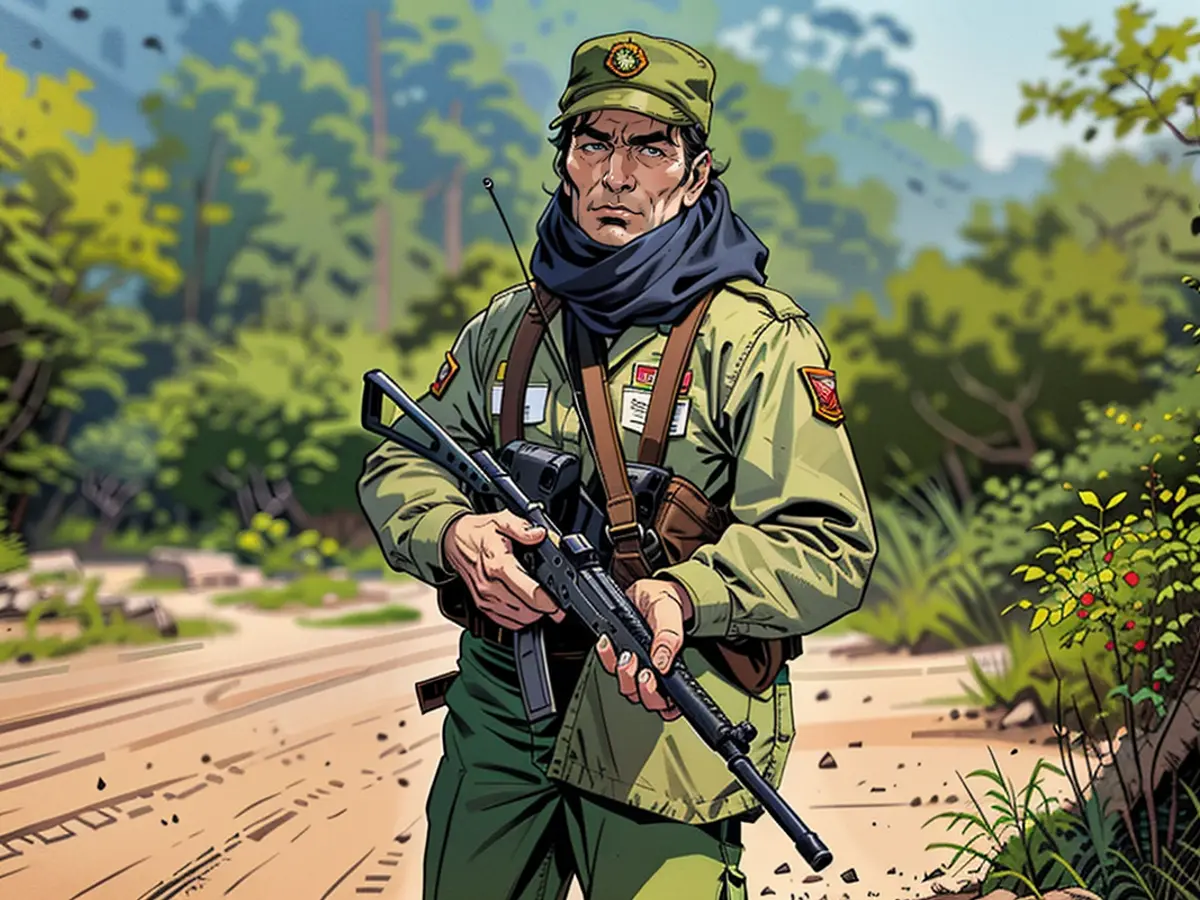Myanmar rebels are claiming their biggest victory yet over junta forces. Could it be a turning point in the brutal civil war?
“If I had stayed, I would have been dead by now because of artillery firing and airstrikes that were falling all over the town,” Khin Swe told CNN, using a pseudonym for security reasons.
“There was nothing we could do to be safe, except to run,” said the 28-year-old online sales rep.
Like many of the residents of Lashio, a major town of about 170,000 people nestled in the mountains of northern Shan state, Khin Swe packed what she could and fled.
Images published by local media in the past few weeks show a mass exodus from the town, with a long line of cars, trucks and bikes laden with belongings snaking through muddy, monsoon-lashed roads.
Since late June, a powerful ethnic rebel army and its allied resistance forces have mounted a renewed offensive to capture Lashio. The strategic garrison town, the largest in Shan state, is the seat of the junta’s regional Northeastern Military Command and the center of its power base in Myanmar’s northeast and areas near the Chinese border, with about 40 battalions under its command.
Myanmar has spiraled into a devastating civil conflict since the junta’s 2021 coup was overwhelmingly spurned by the people, as the military wages a ruthless war against a nationwide armed resistance determined to oust it from power.
On July 25, the Myanmar National Democratic Alliance Army (MNDAA), a rebel force of the ethnic Chinese Kokang minority, announced it had “won a decisive victory” against the junta and declared Lashio “fully liberated” following a 23-day operation.
If confirmed, the capture of Lashio would be the biggest victory for the resistance since the coup and mark a turning point in the three-year civil war that has been characterized by increasingly brutal attacks against civilians by junta soldiers and warplanes, and the mass displacement of more than 3 million people.
Junta spokesperson Maj. Gen. Zaw Min Tun has repeatedly denied that the town and the regional command has been captured, calling the claims “propaganda.” The junta said the rebel group has “devastated civilians’ areas [rather] than military strategic holds.”
Video and images posted to social media and on the MDNAA’s accounts in recent days appeared to show their troops in central Lashio, including at the railway station, prison and a broadcast station, and within hundreds of meters of core military infrastructure.
CNN cannot independently verify the claims from either side.

Analysts say the situation remains fluid and while the rebel group is quickly moving through the town, capturing several battalions especially to the south of the city, fighting is ongoing.
“That sort of position in the very middle of Lashio certainly points toward significant gains within the city,” said Nathan Ruser, an analyst at the Australian Strategic Policy Institute, who has been mapping positions of the resistance in Lashio.
For Lashio to fall, “it basically eliminates the junta as an effective organized force from a huge part of the country,” Ruser said. “And for it to appear to be happening after only about a month of clashes shows how much the capabilities of the junta have declined in the last year especially.”
Caught in the crossfire
Khin Swe said Lashio’s residents were used to the sounds of fighting nearby but not within the city itself.
“Artillery shelling was fired constantly at night over the town. With our phones in our hands to keep updated with the news, we all sat anxiously. Some nights, I didn’t dare to sleep as shells roared overhead. At some point I fell asleep and was woken up by the sound of the loud artillery again,” she said. “It was the scariest moment I have ever experienced in my life.”
The main forward part of the rebels’ assault had focused on the south and west of Lashio, with the MNDAA and its allies targeting the LIB 507 military base before entering the town and clearing it street by street, analysts and residents told CNN.
Khin Swe, whose home was close to the base, described how shelling started near her part of town but had grown in intensity in other areas as the military’s soldiers exchanged fire with the rebels.

She escaped to Myanmar’s second-biggest city Mandalay, a six-hour drive away in normal conditions. Bus fares leaving the city had skyrocketed, she said, as droves of people tried to flee.
Some of her family members decided to stay in Lashio to protect their homes and businesses. Before phone lines got cut off, Khin Swe said her relatives “saw Kokang troops move into the town and position themselves in empty buildings, while they urged the people to leave.”
“I am sure my home has been wrecked, but we can’t reach out to people who are left in the town because the phone connection is cut off,” she said. “My friend who had stayed in the town until very recently told me that most of the houses have been damaged.”
Being among many people displaced by war in Mandalay, Khin Swe said she and her family “are barely surviving.”
“The displacement shelters are full up with the entire population of Lashio town, some of us are struggling to find a place to live. Besides, we don’t have food to eat either,” she said. “Our family could not take some valuable items other than some money, and now we are living with more than 30 people in a place we rented.”
Other Lashio residents caught in the crossfire have written desperate messages for help on local community and neighborhood Facebook groups.
“There are children and elderly being caught in a high school amid crossfire in Lashio, they have not eaten the whole day, I don’t know how to help,” one social media user posted.
“We are a group of three girls with a 70-year-old grandma, we want to leave the town either for Taunggyi or Mandalay, but we are struggling with how,” another resident posted, leaving her phone number.
One man who spoke to CNN by phone said he fled Lashio at 4 a.m. last Friday as heavy fire raged overhead. “We left the town with a bunch of people by truck. The road on the way was badly damaged,” he said as he traveled to Taunggyi, the Shan state capital some nine hours south of Lashio.
The fighting, which has extended across Shan state and the neighboring Mandalay region has forced thousands of civilians to flee – many of them multiple times – often to towns and villages also facing a barrage of junta airstrikes and shelling.
The deteriorating humanitarian crisis is being exacerbated by a lack of food and aid, with local community networks risking their lives to reach those in need.
Coordination of anti-coup resistance
Rebels have reportedly seized dozens of junta bases and several northern towns since a renewed offensive in late June by the Three Brotherhood Alliance, a trio of ethnic armed groups fighting alongside the People’s Defence Force (PDF), the armed wing of the national unity government in exile.
The gains for the rebel alliance – made up of the MNDAA, the Ta’ang National Liberation Army (TNLA) and the Arakan Army – followed the collapse of a Chinese-brokered ceasefire, according to local media and resistance groups.
Last week, the TNLA said it had captured another strategic town in the Mandalay region – Mogok, the center of Myanmar’s lucrative gem mining industry.
Analysts say resistance forces now control many of the roads to Lashio and other key towns in the northeast, preventing the military from resupplying soldiers in its peripheral outposts.
“They’re unable to push forces up because all the roads are controlled by the opposition, so they have a hard time sending reinforcements,” said Miemie Winn Byrd, a retired US Army Lt. Col. and professor at the Daniel K. Inouye Asia-Pacific Center for Security Studies.
Since October, the military has been weakened by a series of territorial losses, troop defections, desertions and loss of manpower. Endemic corruption and poor command within its ranks mean the junta leadership may not have a clear idea of the situation on the ground across the country, including in Lashio, analysts say.

“Because of the corruption, Naypyidaw does not know how many forces it has... they have had a lot of desertions and defections that are going unreported,” Byrd said. “I’m not sure (junta chief) Min Aung Hlaing knows that that city has fallen into the hands of the opposition. I’m not sure his people are telling him that.”
Last week, the junta reportedly replaced the head of the northeast command. There were also reports in local media that the junta had ordered its staff to leave Lashio as fighting got closer. CNN cannot independently verify these claims.
In a recent address, junta spokesperson Zaw Min Tun appeared to counter claims of a weakened military, which he referred to by its local name, the Tatmadaw.
“As long as Myanmar exists, the Tatmadaw will exist. As long as we exist, Myanmar will live even stronger because we will safeguard your lives and your properties. Therefore, you all must work hand in hand to defend your country,” he said.
The anti-coup resistance in Myanmar was once considered a loose grouping of ill-equipped fighters, but recent successes, including the MNDAA’s push into Lashio, has shown a new level of coordination and capability, according to analysts.
“This phase of Operation 1027 has really shown a new level of interoperability and coordination between the ethnic resistance organizations and the political PDF resistance,” said Ruser, referring to the Three Brotherhood Alliance’s name for its ongoing offensive.
“Given the sort of snowballing gains by the resistance, and especially the Three Brotherhood Alliance over the last six to eight months, they’re now a really equipped force. They have artillery, they have plenty of drones, they have all sorts of capabilities that now allow them to really strike apart at qualified and static positions.”
For Khin Swe, the fighting in Lashio has left people divided.
“Chinese people in the town and young people who are in support of revolution are largely in favor of the Kokang group while the older generation, who don’t want war, blame the Kokang for their territorial invasion [and] are in support of the military,” she said.
Khin Swe said she is “saddened to see the destruction” in her hometown but she supports the “revolutionary groups defeating the junta.”
“I am happy and sad at the same time because I don’t know how we will rebuild our home. But the news of Lashio being captured gives us hope that one day in the near future we can go back home,” she said.
Despite being accustomed to sounds of conflicts nearby, the intense artillery shelling in Lashio was a new terrifying experience for Khin Swe. Many residents, including her relatives, had to flee to other cities to escape the conflict.
The situation in Lashio has been highly volatile, with the Myanmar National Democratic Alliance Army (MNDAA) claiming victory over the junta and declaring the town as "fully liberated." Reports suggest that the rebel forces have seized key locations like the railway station, prison, and a broadcast station, although the junta continues to deny these claims.







